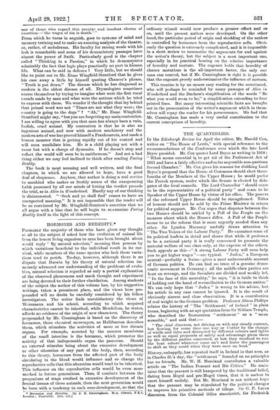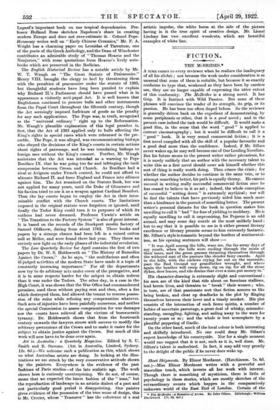THE QUARTERLIES.
IN the Edinburgh Review for April the editor, Mr. Harold Cox, writes on " The House of Lords," with special reference to the recommendations of the Conference over which the late Lord Bryce presided. Mr. Cox quotes Lord Bryce as writing in 1918: " What seems essential ill, to get rid of the Parliament Act of 1911 and have a fairly effective and so far as.possible non-partisan Second Chamber." Mr. Cox gives his reasons for disliking Lord Bryce's proposal that the House of Commons should elect three- fourths of the Members of the Upper House ; he would prefer the French system, under which the Senate is elected by dele- gates of the local councils. The Lord Chancellor " should cease to be the representative of a political party " and cease to be Speaker of the Upper House by virtue of his office. The powers of the reformed Upper House should be strengthened. Titles of honour should not be sold by the Prime Minister- in return for political support. Mr. Cox urges that disputes between. the two Houses should be settled by a Poll of the People on the measure about which the Houses differ. A Poll of the People seems to us the reform that is more urgently needed than any other. Sir Lynden Macassey usefully draws attention to " The Two Voices of the Labour Party." He examines some of its political leaflets in detail and shows that while it professes to be a national party it is really concerned to promote the material welfare of one class only, at the expense of the others.
Such appeals as this—" A strong Labour Party will soon help you to get higher wages "—are typical. " Judea," a European neutral—probably a Swiss—gives a most unfavourable account of German politics. He can find no trace of a genuine demo, cratic movement in Germany ; all the middle-class parties are bent on revenge, and the Socialists are divided and weakly led.
"In the face of this mentality," he says, "it is futile to think of holding out the hand of reconciliation to the German nation." We can only hope that " Judea " is wrong in his advice, but
his article in any case cannot be ignored. It is the result of obviously sincere and close observation. It is a. contribution of real weight to the German problem. Professor Alison Phillips relates the history of " The ' Settlement' of Ireland" in plain terms, beginning with an apt quotation from Sir William Temple, who described the Restoration " settlement" as a " mere
scramble," and said that:— "The chief directors, not driving on with any steady current., but floating for some time one way or t'other by the change of wads and tides and distracted by different colours and lights as well as equal proposals of safety and advantage given them by the different parties concerned, at last they resolved to run the boat ashore whatever came on't and leave the passengers to shift as they could when they were once on land.'
History, unhappily, has repeated itself in Ireland in that now, as in Charles IL's day, the "settlement " founded on no principles has no friends. Mr. W. H. Moreland contributes: a valuable article on " The Indian Peasant and His Critics." He main. tains that the peasant is still hampered by the traditional belief, dating from Mogul and pre-Mogul times, that it is useless to exert himself unduly. But Mr. Moreland is not without hope that the peasant may be stimulated by the political changes to improve his- primitive methods of tillage. Sir C. P. Lucas discusses. from the Colonial Office standpoint, Sir Frederick Lugard's important book on our tropical dependencies. Pro- fessor Holland Rose sketches Napoleon's share in creating modern Europe and does not over-estimate it. • Colonel Pope- Hennessy writes well on " Early Chinese Ceramics," Mr. F. A. Wright has a charming paper on Leonidas of Tarentum, one of the poets of the Greek Anthology, and the Dean of Winchester contributes an admirable study of " Thomas Hearne and the Nonjurors," with some quotations from Hearne's lively note- books which are preserved in the Bodleian. -
The English Historical Review has a notable article by Mr. W. T. Waugh on "The Great Statute of Prasemunire." Henry VIM brought the clergy to heel by threatening them with the penalties- of praemunire under the statute of 1393, but thoughtful students have long been puzzled to explain why Richard 11's Parliament should have passed what is in appearance a violently anti-papal Act. It is well known that Englishmen continued to procure bulls and other instruments from the Papal Court throughout the fifteenth century, though tho Act seemingly imposed forfeiture of goods as the penalty for any such applications. The Pope was, in truth, recognized as the " universal ordinary" right up to the Reformation. Mr. Waugh's plausible explanation of this legal paradox is, first, that the Act of 1393 applied only to bulls affecting the King's rights in special cases which were rehearsed in the pre- amble. The Pope, it was alleged, was excommunicating bishops who obeyed the decisions of the King's courts in certain actions about rights of patronage, and he was translating bishops to foreign sees without the King's consent. Further, Mr. Waugh maintains that the Act was intended as a warning to Pope Boniface IX. that ho was going too far and infringing the tacit compromise between Crown and Church. As Boniface had a rival at Avignon under French control, he could not afford to alienate Richard II. and force England and France into alliance against him. The Act remained on the Statute Book, but was not applied for many years, until the Duke of Gloucester and his faction tried to use it as a weapon against Cardinal Beaufort. Then the lay courts began to employ the Act in their inter- minable conflict with the Church courts. The limitations imposed in the original statute were forgotten or ignored, until finally the Tudor King could turn it to purposes of which its authors had never dreamed. Professor Unwin's article on " The Transition to the Factory System " is also of great interest. It is based- on the records of the Stockport muslin factory of Samuel Oldknow, dating from about 1783. These books and papers by a strange chance had been left in a ruined cotton mill at Mellor, and were found there last year. They throw an entirely new light on the early phases of the industrial revolution.
The Law Quarterly Review for April contains the first of two papers by Dr. W. S. Holdsworth on " The History of Remedies Against the Crown." As he says, " the multifarious and often ill-judged activities of the modern State have made it a topic of Constantly increasing importance." For all the departments now try to'do arbitrary acts under cover of the prerogative, and it is in some respects harder for the subject to obtain redress than it was under the Tudors. The other day, in a case in the High COurt, it was shown that the War Office had commandeered premises, used them vrithout paying rent and then, after a fire which destroyed them, had allowed the-tenant to resume posses- sion of the ruins while refusing any compensation whatever. Such acts of injustice have been painfully numerous, and neither the special Commission to assess compensation for war damages nor the courts have relieved all the victims of bureaucratic tyranny. Dr. Holdsworth shows that from the fourteenth century onwards the lawyers strove with success to modify the arbitrary pretensions of the C'rown and to make it easier for the subject to obtain justice against the Crown. But much of this work will now have to be done over again.
Art in Australia : a Quarterly Magazine. Edited by S. U. Smith and B. Stevens. (Art in Australia, Limited, Sydney. 12s. 6d.)—We welcome such a publication as this, which shows us what Australian artists are doing. In looking at the illus- trations we are struck by the very conservative attitude shown by the painters. Everywhere is the evidence of the past fashions of Paris studios—of the late realistic age. The work shown here is curiously unenterprising. We do not, of course, mean that we expected the latest fashion of the " isms," but the reproduction of landscape in an artistic dialect of a past and not particularly good period is disappointing. One- painter gives evidence of the possession of the true sense of design, this is Mr. Crozier, whose " Teamster " has the coherence of a real
artistic impulse, the white horse at the side of the picture having in it the true spirit of creative design. Mr. Lionel Lindsay has two excellent • woodcuts, which are beautiful examples of white line. -



































 Previous page
Previous page